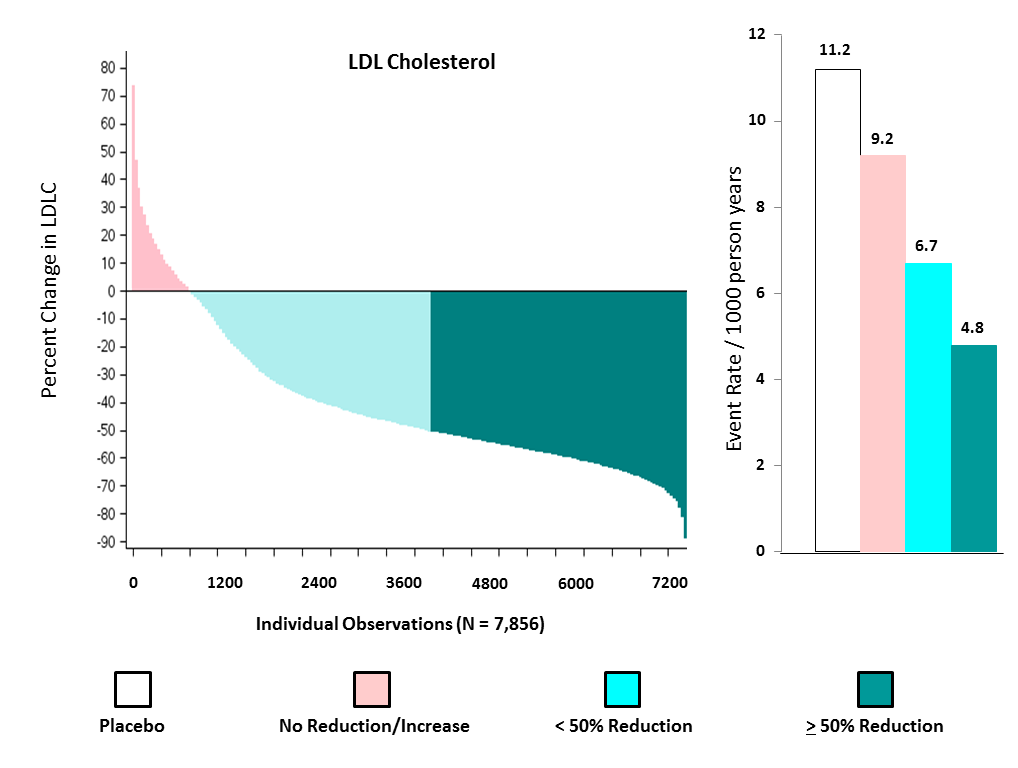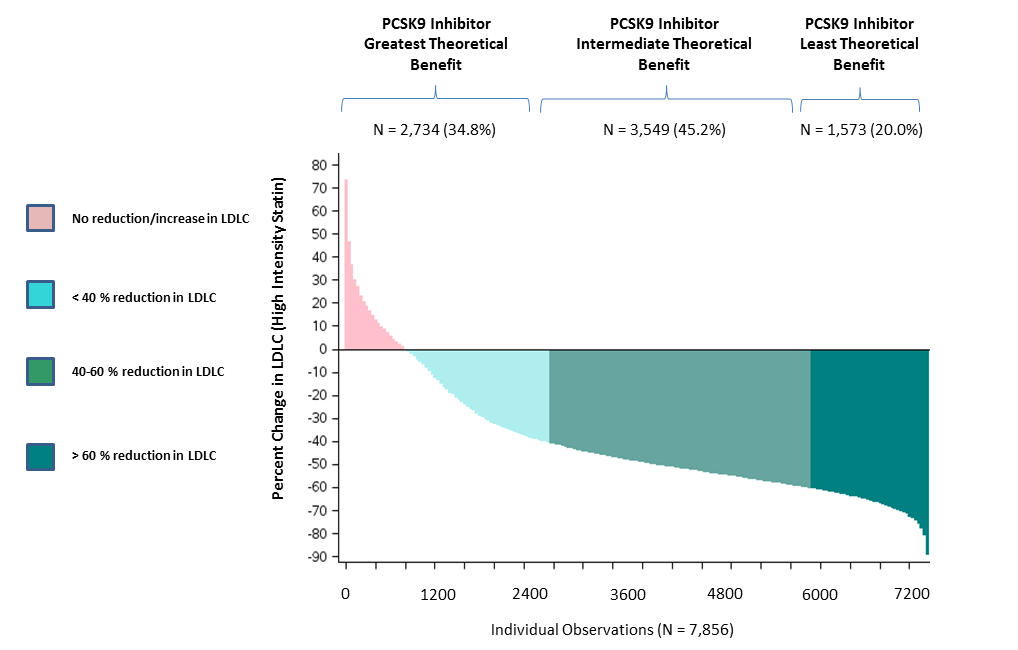Lowering LDL Cholesterol: When Numbers are Not Enough
Introduction
Clinicians worldwide continue to be challenged by cholesterol management for their patients; specifically, whether to attempt low-density lipoprotein (LDL-C) reduction to previously described targets, or to specific percent reductions (e.g., ≥ 50% or < 50%) based on an individual's risk assessment as advocated by the US Guidelines.1 Indeed, Canadian and European Guidelines suggest using both strategies.2,3 Data addressing whether the high-intensity statin strategy (to achieve ≥ 50% LDL-C reduction) correlates with improved cardiovascular outcomes is limited.
In addition, it is known that LDL-C reduction to the same strength of statin can vary widely in the population4 resulting in a significant number of patients who may continue to be at increased, potentially modifiable risk, for future events. Recently, the Treating to New Targets (TNT) investigators reported in their known coronary artery disease patient population that visit-to-visit variability in LDL-C levels correlated with increased cardiovascular risk, suggesting yet another possible contributor to residual risk, reportedly independent of LDL-C levels.9
With the recent addition of proprotein convertase subtilisin/kexin type 9 (PCSK9) inhibitors to the clinicians' cholesterol lowering armamentarium, it is important to define goals of treatment and which specific patients may derive the greatest benefit of new treatment strategies. Our most recent analysis of the Justification for the Use of Statins in Prevention: An Intervention Trial Evaluating Rosuvastatin (JUPITER) trial was designed to examine these clinical questions further and to address the relationship of percent LDL-C reduction with clinical outcomes and cardiovascular event rates.5
Study Design
JUPITER study participants included 17,802 asymptomatic women ≥ 60 years and men ≥50 years who had LDL-C < 130 mg/dL, high-sensitivity C-reactive protein (hsCRP) ≥ 2.0 mg/L and triglycerides < 500 mg/dL.6 Patients with previous cardiovascular disease, diabetes or lipid-lowering therapy were excluded. At randomization, all participants were assigned to either rosuvastatin 20 mg daily or to matching placebo. Patients were followed prospectively for a period up to 5 years (median 2 years) for the occurrence of first cardiovascular events.
Blood samples were collected at baseline and follow up after participants fasted for 8 hours. In the current analysis, paired samples were used at baseline and at 1 year follow up. Measurements were obtained for total cholesterol, triglycerides, high-density lipoprotein cholesterol (HDL-C), apolipoprotein B (apoB) and hsCRP values. LDL-C concentrations were either calculated via the Friedwald equation when triglycerides were < 400 mg/dL or measured directly when triglycerides where ≥ 400 mg/dL. Non-HDL-C values were calculated by subtraction of HDL-C from total cholesterol.
Trial primary outcome was as pre-specified in the JUPITER protocol6 defined as the first occurrence of non-fatal myocardial infarction, non-fatal stroke, hospitalization for unstable angina, arterial revascularization, or cardiovascular death.
Four patient groups were assessed as follows: 1) Placebo control; 2) those on rosuvastatin who achieved a ≥ 50% LDL-C reduction; 3) those on rosuvastatin who achieved >0% but < 50% LDL-C reduction; and 4) those on rosuvastatin who had no reduction or an increase in LDL-C compared to baseline. Incident event rates and 95% confidence intervals (CIs) were calculated for the trial endpoint.
Cox proportional hazards were used to estimate hazard ratios (HRs) and 95% CIs for the comparison of cardiovascular events in each statin-treated group compared with placebo. Multivariate hazard ratios (95% CIs) were also computed after adjusting for those variables found on regression analysis to have a significant impact on on-treatment LDL-C levels, including baseline LDL-C. All analyses were repeated separately for non-HDL-C and apo B. Analyses were also repeated using tertiles of percent lipid reduction rather than the pre-specified ≥ 50% threshold.
Results
As previously reported in the JUPITER trial, rosuvastatin 20 mg resulted in a median 50% reduction in LDL-C. A wide inter-individual variability was observed in %LDL-C reduction as shown in Fig.1. Multivariate analysis demonstrated that significant predictors of lower on-treatment lipid levels included lower baseline lipid levels, male sex, Caucasian ancestry, higher age, higher BMI, and lower levels of hsCRP (all P values <0.05).
As shown in Fig.1, for those patients allocated to 20 mg of rosuvastatin the magnitude of % LDL-C reduction was directly related to the incidence of first cardiovascular events observed during the trial follow up period. After adjusting for covariates predictive of change in lipid levels (including baseline LDL-C levels), adjusted HRs were all significant (P< 0.00001). Similar results were seen in non-HDL-C reduction and apo B reduction, with again wide variability in individual response. In sensitivity analysis using tertiles of % reduction, similar findings were obtained.
Discussion/Commentary
Several important findings are highlighted in this secondary analysis from the JUPITER trial. Firstly, the data obtained in this primary prevention population show that sequentially greater clinical benefits are seen with sequentially greater % reductions in cholesterol on statin therapy. This held true when adjusting for characteristics associated with greater lipid response to statin therapy and also in a subgroup analysis of those who achieved on-treatment levels of LDL-C between 50 and 75 mg/dL. These findings are consistent with outcomes of the recent secondary prevention IMPROVE-IT trial that demonstrated decreased event rates with greater LDL-C reductions in patients following an acute coronary syndrome.7
Secondly, we also observed wide individual variation in the % reduction in cholesterol in response to statin therapy, consistent with clinical practice and previously published data. A complex interplay of genetic influences on cholesterol metabolism, including the previously described PCSK9, APOE, LPA and ABCG2 genes,8 behavioral and environmental factors such as medication compliance and diet and exercise, likely play a role in the observed variability. In addition, patients with heterozygous familial hypercholesterolemia and/or elevated lipoprotein(a) levels may have less response to statin therapy.
Patients enrolled in JUPITER all had LDL-C values < 130 mg/dL but elevated hsCRP and hence they were not low risk patients. This most recent analysis of the data leads us to support an individualized approach to cholesterol management with attention to % LDL-C reduction, in addition to fixed LDL-C targets. Clinicians should probe into the modifiable reasons for a patient not achieving the expected LDL-C targets or % reduction with careful attention to the patient's behavioral response on medications. Frequent assessment of diet and exercise can reveal less than ideal practices, despite medication adherence, with the potential to impact both cholesterol values and residual cardiovascular risk.
The importance of reducing LDL-C by at least 50% has also recently been endorsed by Waters et al. after their pooled analysis of several randomized trials from patients with known atherosclerotic disease, which suggested that % LDL-C reduction added incremental prognostic value over LDL-C attained or statin dose utilized.10 In high risk patients who fail to achieve a 50% LDL-C reduction, the addition of alternative cholesterol lowering agents may be considered. Given the significant LDL-C lowering observed with PCSK9 inhibitors, there may be a potential future application for these drugs in these patients as illustrated in Fig.2, if they are proven to be efficacious in reducing clinical events.
Future outcomes data from PCSK9 inhibitor trials will be of significant importance when deciding on adjunctive agents in high-risk patients with suboptimal statin response. Meanwhile, more emphasis should be placed on lifestyle and behavioral modifications that could increase the percent reduction in LDL-C during statin therapy. Such an optimal prevention strategy for reducing LDL-C and cardiovascular events should emphasize the importance of regular physical activity together with attaining and maintaining an optimal body weight and a healthy Mediterranean-style diet.
Figure 1
Figure 2
References
- Stone NJ, Robinson J, Lichtenstein AH, BaireyMerz CN, Blum CB, Eckel RH, Goldberg AC, Gorden D, Levy D, Lloyd-Jones DM, McBride P, Schwartz JS, Shero ST, Smith SC, Watson K, Wilson PWF. 2013 ACC/AHA guideline on the treatment of blood cholesterol to reduce atherosclerotic cardiovascular risk in adults; a report of the American College of Cardiology/American Heart Association Task Force on Practice Guidelines. J Am Coll Cardiol 2014; 63: 2889-2934
- Perk J, De Backer G, Gohlke H, Graham I, Reiner Z, Verschuren M, Albus C, Benlian P, Boysen G, Cifkova R, DeatonC, Ebrahim S, Fisher M, Germano G, Hobbs R, Hoes A, Karadeniz S, Mezzani A, Prescott E, Ryden L, Scherer M, Syvane M, Scholte op Remier WJ, Vrints C,Wood D, Zamorano JL, Zannad F. European Guidelines on cardiovascular disease prevention in clinical practice (version 2012) Eur Heart J 2012;33:1635-1701.
- Anderson TJ, Grégoire J, Hegele RA, Couture P, Mancini GB, McPherson R, Francis GA, Poirier P, Lau DC, Grover S, Genest J Jr, Carpentier AC, Dufour R, Gupta M, Ward R, Leiter LA, Lonn E, Ng DS, Pearson GJ, Yates GM, Stone JA, UR E. 2012 Update of the Canadian Cardiovascular Society guidelines for the diagnosis and treatment of dyslipidemia for prevention of cardiovascular disease in the adult. Can J Cardiol 2013; 29; 151-167.
- Boekholdt SM, Hovingh GK, Mora S, Arsenault BJ, Amerenco P, Pedersen TR, LaRosa JC, Waters DD, DeMico DA, Simes RJ, Keech AC, Colquhoun D, Hitman GA, Betteridge DJ, Clearfield MB, Downs JR, Colhoun HM, Gotto AM, Ridker PM, Grundy SM, Kastelein JJP. Very low levels of atherogenic lipoproteins and the risk for cardiovascular events. A meta-analysis of statin trials. J Am Coll Cardiol 2014; 64:485-494.
- Ridker PM, Mora S, Rose L on behalf of the Jupiter Trial study group. Per cent reduction in LDL cholesterol following high-intensity statin therapy: potential implications for guidelines and for the prescription of emerging lipid-lowering drugs. European Heart Journal in press, March 2016.
- Ridker PM, Danielson E, Fonseca FA, Genest J, Gotto AM Jr, Kastelein JJ, Koenig W, Libby P, Lorenzatti AJ, MacFayden JG, Nordestgaard BG, Shepherd J, Willerson JT, Glynn RJ. Rosuvastatin to prevent cardiovascular events in men and women with elevated C-reactive protein. N Engl J Med 2008; 359:2195-2207.
- Cannon CP, Blazing MA, Giugliano RP, McCagg A, White JA, Theroux P, Darius H, Lewis BS, Ophuis TO, Jukema JW, D Ferrari GM, Ruzyllo W, De Lucca P, Im KA, Bohula EA, Reist C, Wiviott SD, Tershakovec AM, Musliner TA, Braunwald E, Califf RM for the IMPROVE-IT Investigators. Ezetimibe added to statin therapy after acute coronary syndromes.
- Chasman DI, Giulianini F, Macfayden J, Barratt BJ, Nyberg F, Ridker PM. Genetic determinants of statin induced low-density lipoprotein cholesterol reduction; the Justification for the Use of Statins in Prevention; an Intervention Trial Evaluating Rosuvastatin (JUPITER) trial. Circ Cardiovasc Genet 2012; 5;257-264.
- Bangalore S, Breazna A, DeMicco DA, Wun CC, Messerlli FH, on behalf of the TNT Steering Committee and Investigators. Visit-to-visit low density lipoprotein cholesterol variability and risk of cardiovascular outcomes. Insights from the TNT trial. J Am Coll Cardiol 2015; 65;1539-1548.
- Bangalore S, Fayyad R, Kastelein JJ, Laskey R, Amarenco P, DeMicco D, Waters, D. 2013 Cholesterol Guidelines revisited: Percent LDL reduction or attained LDL cholesterol level or both for Prognosis? American Journal of Medicine, in press Nov 2015.
Keywords: Acute Coronary Syndrome, Angina, Unstable, Apolipoproteins B, Apolipoproteins E, Body Mass Index, Body Weight, C-Reactive Protein, Cholesterol, Cholesterol, HDL, Confidence Intervals, Coronary Artery Disease, Diabetes Mellitus, Diet, Ficus, Hospitalization, Hydroxymethylglutaryl-CoA Reductase Inhibitors, Hyperlipoproteinemia Type II, Life Style, Lipoprotein(a), Lipoproteins, HDL, Lipoproteins, LDL, Medication Adherence, Motor Activity, Multivariate Analysis, Myocardial Infarction, Proprotein Convertases, Randomized Controlled Trials as Topic, Regression Analysis, Risk Assessment, Risk Factors, Secondary Prevention, Stroke, Subtilisins, Triglycerides, Primary Prevention
< Back to Listings


